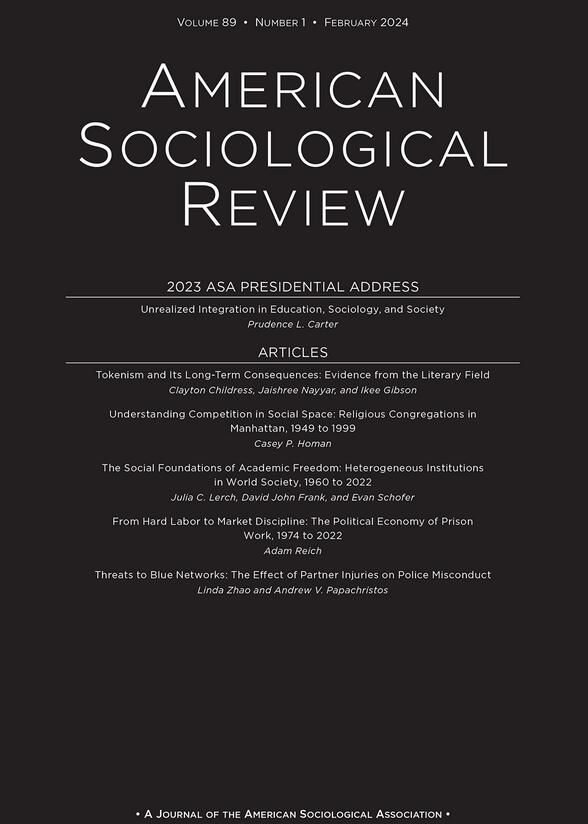财富积累与机会囤积:一个斯堪的纳维亚国家四分之一世纪以来的阶级来源的财富差距
IF 6.2
1区 社会学
Q1 SOCIOLOGY
引用次数: 23
摘要
虽然斯堪的纳维亚国家通常被认为是社会民主治理的缩影,但斯堪的纳维亚深刻的财富不平等,与更适度的收入差异有关,构成了一个迷人的悖论。利用阶级理论对再生产策略的关注和布尔迪厄学派对阶级分数的强调,我们探讨了挪威在过去25年里阶级起源的财富差距是如何演变的,以及它们如何与阶级起源的收入差距进行比较。首先,我们发现近年来阶级出身的财富差距有所扩大,而收入不平等在男性中相当持久,在女性中也在增加。我们发现,受教育程度对于疏导收入不平等很重要,但对于理解贫富差距则不那么重要。其次,我们记录了家庭背景具有高度经济资本的人和在从事文化领域或专业的家庭中长大的人之间的差异。最后,我们强调了仅基于净资产的分析如何忽视了阶级起源通过获得债务而延续和加速财富不平等的重要途径。我们认为,近几十年来,经济上层阶级的子女最成功地利用了囤积机会的新工具。本文章由计算机程序翻译,如有差异,请以英文原文为准。
Wealth Accumulation and Opportunity Hoarding: Class-Origin Wealth Gaps over a Quarter of a Century in a Scandinavian Country
Although the Scandinavian countries are often considered to epitomize social democratic governance, Scandinavia’s profound wealth inequalities, seen in relation to the more modest income differences, constitutes a fascinating paradox. Drawing on class theoretical concerns with strategies for reproduction and a Bourdieusian emphasis on class fractions, we explore how class-origin wealth gaps evolved over the past 25 years in Norway, and how they compare to class-origin income gaps. First, we find that class-origin wealth gaps have increased in recent years, whereas income inequalities are fairly persistent among men, and increasing among women. We find that educational attainment is important for channeling income inequality, but that education is less important for understanding wealth gaps. Second, we document differences between people whose family contexts were most highly endowed with economic capital and those who grew up in families that were engaged in cultural fields or the professions. Finally, we highlight how analyses based solely on net worth neglect important ways class origin perpetuates and accelerates wealth inequalities via the acquisition of debt. We argue that recent decades have fostered new instruments for opportunity hoarding that are most successfully used by the sons and daughters of the economic upper class.
求助全文
通过发布文献求助,成功后即可免费获取论文全文。
去求助
来源期刊

American Sociological Review
SOCIOLOGY-
CiteScore
13.30
自引率
3.30%
发文量
35
期刊介绍:
The American Sociological Association (ASA) is a non-profit membership association established in 1905. Its mission is to advance sociology as a scientific discipline and profession that serves the public good. ASA is comprised of approximately 12,000 members including faculty members, researchers, practitioners, and students in the field of sociology. Roughly 20% of the members work in government, business, or non-profit organizations.
One of ASA's primary endeavors is the publication and dissemination of important sociological research. To this end, they founded the American Sociological Review (ASR) in 1936. ASR is the flagship journal of the association and publishes original works that are of general interest and contribute to the advancement of sociology. The journal seeks to publish new theoretical developments, research results that enhance our understanding of fundamental social processes, and significant methodological innovations. ASR welcomes submissions from all areas of sociology, placing an emphasis on exceptional quality.
Aside from ASR, ASA also publishes 14 professional journals and magazines. Additionally, they organize an annual meeting that attracts over 6,000 participants. ASA's membership consists of scholars, professionals, and students dedicated to the study and application of sociology in various domains of society.
 求助内容:
求助内容: 应助结果提醒方式:
应助结果提醒方式:


